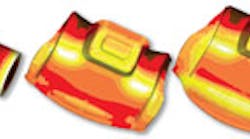Hot forging designers who perform metal-flow simulation often start with an invalid assumption on the initial billet temperature: They assume that the initial temperature of the billet is uniform.
In reality though, the temperature of the billet is not uniform, and this will have an effect on the material flow. Flow stress varies as a function of temperature, and if the initial temperature is not correctly defined it can lead to unexpected material-flow problems. Up until now, the only solution was to make assumptions based on experience and actual measurements, and then to initialize the billet temperature with this approximated data.
During the Hannover Fair 2009, a better solution was proposed for ABP Induction customers who use the Simufact.forming metal forming software, from Simufact Engineering GmbH (www.simufact-americas.com). The proposed idea was to couple ABP Induction’s THERMPROF software package with Simufact.forming, allowing hot forging designers to fully account for the results of ABP’s modular induction heating process during metal flow simulations.
The Simufact.forming software package is the only metal forming simulation program that offers a fully integrated 3D and 2D solution, using two well-known solution methods — the Finite Element Method and the Finite Volume Method. The software is based on the merger of two separate, long-established programs, MSC.SuperForm and MSC.SuperForge, which at the end of 2006 were divested by MSC.Software to Simufact Engineering GmbH.
Typical examples of simulations are hot and cold forging, tool and die stress analysis, ring-rolling, extrusion, and reducing. One benefit gained from these simulations involves early detection of flaws in the process, like die under-fill and creation of cracks, folds, and laps. It also allows evaluation of the die and forming loads, the stresses that are developed inside the dies, and determination of the residual stresses in the part after forming.
Researchers at ABP Induction developed the THERMPROF software package in support of the company’s innovative forge-heating concept, which is based on multi-converter technology. This heating approach enables the energy input to be regulated zone by zone, providing a great flexibility to economically cope with different work-piece dimensions.
The THERMPROF software is used to find the correct setting for actuating the converter modules individually, without time-consuming and cost-intensive trials. This allows the expected temperature profile to be numerically calculated and the heating optimized in consideration of individual aspects. Together with the desired ingot dimensions and the required throughput or tact cycle, the target average temperature of the ingots at the end of each separately controllable zone can be stipulated. The software functions extend to displaying the temperature course in the forged part from the start of the first heating up to the first deformation. A cost calculator is included, too.
After the introduction of the linkage concept, several companies expressed great interest and acknowledged the importance of this functionality. As a result, the development of the link between THERMPROF and Simufact.forming was accelerated. Recently, it was completed. The software link is currently going through final verification testing, and will become available to customers during Q2 of 2010. The software link was unveiled for the first time on February 10, during the ABP Induction LLC customer day, in Brookfield, Wisconsin.
Once the software has passed final verification testing, it will be made available to the mechanical engineering department at Ohio University, in Athens. As a FIERF Magnet School, it participates in the academic program of Simufact, and receives early access to its software for R&D purposes. The department has a 5-kW induction heater that can be controlled using a thermocouple feedback. In addition, a billet can be instrumented to determine the internal temperature profile. This experimental setup will allow for a thorough validation of software against real world cases.
| For more details on Simufact. forming, contact arjaan.[email protected]. Or, visit www.simufact-americas.com For more details on THERMPROF, visit www.ABPinduction.com/heating For more details on Ohio University, visit www.ent.ohiou.edu/me |










